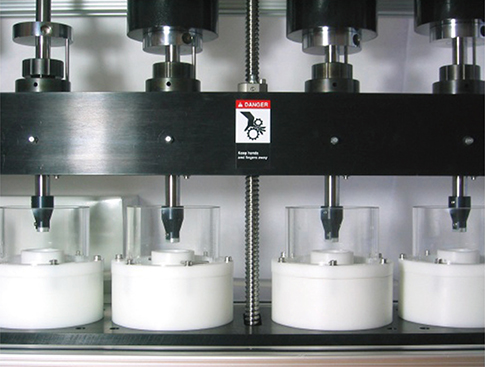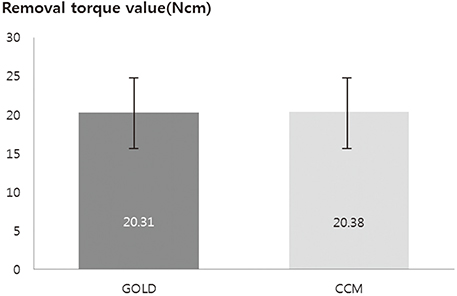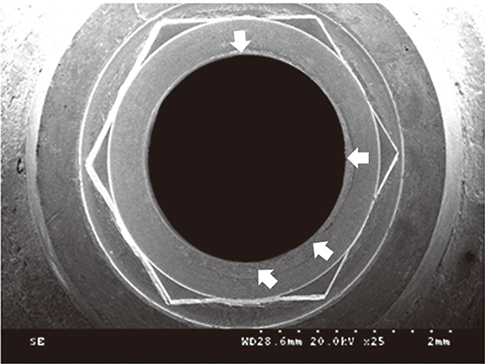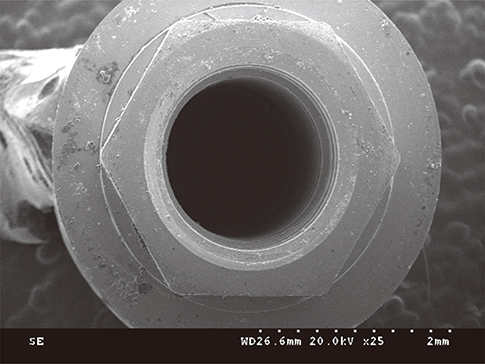J Adv Prosthodont.
2016 Dec;8(6):465-471. 10.4047/jap.2016.8.6.465.
Evaluation of stability of interface between CCM (Co-Cr-Mo) UCLA abutment and external hex implant
- Affiliations
-
- 1Department of Prosthodontics, Oral Science Research Center, Yonsei University College of Dentistry, Seoul, Republic of Korea. kwlee@yuhs.ac
- 2BK21 PLUS Project, Yonsei University College of Dentistry, Seoul, Republic of Korea.
- KMID: 2382592
- DOI: http://doi.org/10.4047/jap.2016.8.6.465
Abstract
- PURPOSE
The purpose of this study is to evaluate the stability of interface between Co-Cr-Mo (CCM) UCLA abutment and external hex implant.
MATERIALS AND METHODS
Sixteen external hex implant fixtures were assigned to two groups (CCM and Gold group) and were embedded in molds using clear acrylic resin. Screw-retained prostheses were constructed using CCM UCLA abutment and Gold UCLA abutment. The external implant fixture and screw-retained prostheses were connected using abutment screws. After the abutments were tightened to 30 Ncm torque, 5 kg thermocyclic functional loading was applied by chewing simulator. A target of 1.0 × 10ⶠcycles was applied. After cyclic loading, removal torque values were recorded using a driving torque tester, and the interface between implant fixture and abutment was evaluated by scanning electronic microscope (SEM). The means and standard deviations (SD) between the CCM and Gold groups were analyzed with independent t-test at the significance level of 0.05.
RESULTS
Fractures of crowns, abutments, abutment screws, and fixtures and loosening of abutment screws were not observed after thermocyclic loading. There were no statistically significant differences at the recorded removal torque values between CCM and Gold groups (P>.05). SEM analysis revealed that remarkable wear patterns were observed at the abutment interface only for Gold UCLA abutments. Those patterns were not observed for other specimens.
CONCLUSION
Within the limit of this study, CCM UCLA abutment has no statistically significant difference in the stability of interface with external hex implant, compared with Gold UCLA abutment.
Figure
Reference
-
1. Merickse-Stern R, Aerni D, Geering AH, Buser D. Long-term evaluation of non-submerged hollow cylinder implants. Clinical and radiographic results. Clin Oral Implants Res. 2001; 12:252–259.2. Becker W, Becker BE, Alsuwyed A, Al-Mubarak S. Long-term evaluation of 282 implants in maxillary and mandibular molar positions: a prospective study. J Periodontol. 1999; 70:896–901.3. Bahat O. Brånemark system implants in the posterior maxilla: clinical study of 660 implants followed for 5 to 12 years. Int J Oral Maxillofac Implants. 2000; 15:646–653.4. Lewis SG, Llamas D, Avera S. The UCLA abutment: a four-year review. J Prosthet Dent. 1992; 67:509–515.5. Baldassarri M, Hjerppe J, Romeo D, Fickl S, Thompson VP, Stappert CF. Marginal accuracy of three implant-ceramic abutment configurations. Int J Oral Maxillofac Implants. 2012; 27:537–543.6. Leutert CR, Stawarczyk B, Truninger TC, Hämmerle CH, Sailer I. Bending moments and types of failure of zirconia and titanium abutments with internal implant-abutment connections: a laboratory study. Int J Oral Maxillofac Implants. 2012; 27:505–512.7. Nothdurft FP, Doppler KE, Erdelt KJ, Knauber AW, Pospiech PR. Fracture behavior of straight or angulated zirconia implant abutments supporting anterior single crowns. Clin Oral Investig. 2011; 15:157–163.8. Marti A. Cobalt-base alloys used in bone surgery. Injury. 2000; 31:18–21.9. Breeding LC, Dixon DL, Nelson EW, Tietge JD. Torque required to loosen single-tooth implant abutment screws before and after simulated function. Int J Prosthodont. 1993; 6:435–439.10. Dixon DL, Breeding LC, Sadler JP, McKay ML. Comparison of screw loosening, rotation, and deflection among three implant designs. J Prosthet Dent. 1995; 74:270–278.11. Henry PJ, Laney WR, Jemt T, Harris D, Krogh PH, Polizzi G, Zarb GA, Herrmann I. Osseointegrated implants for single-tooth replacement: a prospective 5-year multicenter study. Int J Oral Maxillofac Implants. 1996; 11:450–455.12. Becker W, Becker BE. Replacement of maxillary and mandibular molars with single endosseous implant restorations: a retrospective study. J Prosthet Dent. 1995; 74:51–55.13. Patterson EA, Johns RB. Theoretical analysis of the fatigue life of fixture screws in osseointegrated dental implants. Int J Oral Maxillofac Implants. 1992; 7:26–33.14. Goheen KL, Vermilyea SG, Vossoughi J, Agar JR. Torque generated by handheld screwdrivers and mechanical torquing devices for osseointegrated implants. Int J Oral Maxillofac Implants. 1994; 9:149–155.15. Mitrani R, Nicholls JI, Phillips KM, Ma T. Accuracy of electronic implant torque controllers following time in clinical service. Int J Oral Maxillofac Implants. 2001; 16:394–399.16. Gutierrez J, Nicholls JI, Libman WJ, Butson TJ. Accuracy of the implant torque wrench following time in clinical service. Int J Prosthodont. 1997; 10:562–567.17. Haack JE, Sakaguchi RL, Sun T, Coffey JP. Elongation and preload stress in dental implant abutment screws. Int J Oral Maxillofac Implants. 1995; 10:529–536.18. Koistinen A, Santavirta S, Lappalainen R. Apparatus to test insertion and removal torque of bone screws. Proc Inst Mech Eng H. 2003; 217:503–508.19. Standlee JP, Caputo AA, Chwu MY, Sun TT. Accuracy of mechanical torque-limiting devices for implants. Int J Oral Maxillofac Implants. 2002; 17:220–224.20. Yousef H, Luke A, Ricci J, Weiner S. Analysis of changes in implant screws subject to occlusal loading: a preliminary analysis. Implant Dent. 2005; 14:378–382.21. Jaarda MJ, Razzoog ME, Gratton DG. Effect of preload torque on the ultimate tensile strength of implant prosthetic retaining screws. Implant Dent. 1994; 3:17–21.22. Jörnéus L, Jemt T, Carlsson L. Loads and designs of screw joints for single crowns supported by osseointegrated implants. Int J Oral Maxillofac Implants. 1992; 7:353–359.23. Theoharidou A, Petridis HP, Tzannas K, Garefis P. Abutment screw loosening in single-implant restorations: a systematic review. Int J Oral Maxillofac Implants. 2008; 23:681–690.24. Truninger TC, Stawarczyk B, Leutert CR, Sailer TR, Hämmerle CH, Sailer I. Bending moments of zirconia and titanium abutments with internal and external implant-abutment connections after aging and chewing simulation. Clin Oral Implants Res. 2012; 23:12–18.25. Bates JF, Stafford GD, Harrison A. Masticatory function - a review of the literature. III. Masticatory performance and efficiency. J Oral Rehabil. 1976; 3:57–67.26. Richter EJ. In vivo vertical forces on implants. Int J Oral Maxillofac Implants. 1995; 10:99–108.27. Merz BR, Hunenbart S, Belser UC. Mechanics of the implant-abutment connection: an 8-degree taper compared to a butt joint connection. Int J Oral Maxillofac Implants. 2000; 15:519–526.28. Schwarz MS. Mechanical complications of dental implants. Clin Oral Implants Res. 2000; 11:156–158.29. Delaunay C, Petit I, Learmonth ID, Oger P, Vendittoli PA. Metal-on-metal bearings total hip arthroplasty: the cobalt and chromium ions release concern. Orthop Traumatol Surg Res. 2010; 96:894–904.
- Full Text Links
- Actions
-
Cited
- CITED
-
- Close
- Share
- Similar articles
-
- Influence of implant-abutment interface design, implant diameter and prosthetic table width on strength of implant-abutment interface: three-dimensional finite element analysis
- Effects of abutment angulation and type of connection on the fracture strength of zirconia abutments
- A vitro study of retained screw stability by various connection designs between fixture and abutment in implant dentistry
- Concept and application of implant connection systems: Part II. Placement and restoration of external connection implant and tissue level implant
- The change of rotational freedom following different insertion torques in three implant systems with implant driver









